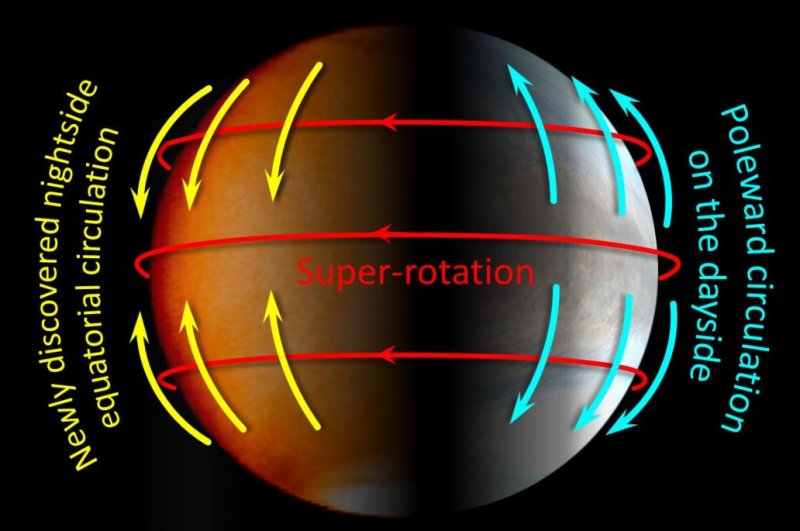Researchers think that dayside poleward circulation on Venus, combined with newly discovered nightside equatorial circulation, may together fuel the planetwide super-rotation that drives weather there. Photo by JAXA/Imamura, et al.
July 21 (UPI) -- Scientists have developed a new way to study Venus' nighttime weather using the infrared sensors aboard the orbiter Akatsuki.
Venus, Earth's nearest planetary neighbor, boasts a dense, highly dynamic atmosphere with the strongest greenhouse effect in the solar system. The surface of Venus is extremely hot, but the planet's upper atmosphere is somewhat Earth-like.
In fact, scientists suggest Venus' weather could offer insights into the mechanisms fundamental to Earth's weather patterns.
Unfortunately, the lack of light makes it difficult to study weather occurring on the half of Venus facing away from the sun. Previous infrared observations of Venus' nighttime weather yielded hazy, incomplete pictures.
Now, with the help of Akatsuki, a Japense orbiter launched in 2010, scientists have found a way to clearly render Venus' nighttime weather. Researchers detailed the breakthrough in the new paper, published Wednesday in the journal Nature.
Akatsuki features an infrared imager that doesn't need help from the sun's rays. However, the imager alone was sufficient to observe Venus' night weather.
To figure out what weather on the dark side of Venus looks like, scientists had to do some significant data analysis.
"Small-scale cloud patterns in the direct images are faint and frequently indistinguishable from background noise," study co-author Takeshi Imamura said in a press release.
"To see details, we needed to supress the noise. In astronomy and planetary science, it is common to combine images to do this, as real features within a stack of similar images quickly hide the noise," said Imamura, a professor at the University of Tokyo.
Venus and its weather moves so quickly, however, that normal techniques for combining images don't work.
Thankfully, Imamura and his research partners were able to develop new analytical methods to compensate for the tremendous speeds at which Venus' weather system rotates.
The new methods allowed researchers to render Venus' nighttime weather in unprecedented detail, and they are hopeful that their renderings will reveal the mechanisms that underlie the planet's rapidly rotating weather patterns.
"We are finally able to observe the north-south winds, known as meridional circulation, at night. What's surprising is these run in the opposite direction to their daytime counterparts," Imamura said.
"Such a dramatic change cannot occur without significant consequences. This observation could help us build more accurate models of the Venusian weather system which will hopefully resolve some long-standing, unanswered questions about Venusian weather and probably Earth weather too," Imamura said.
NASA and the European Space Agency are both planning new missions to explore Venus and its dynamic atmosphere in the near future.
Many planetary scientists have hypothesized that Venus was once a lot more like Earth than it is today.
Scientists expect observations captured by the DaVinci+ and Veritas missions, when combined with data from Akatsuki, will provide insights not only into Venus' current weather patterns, but also its geologic past.















